Human Resource Management Practices
VerifiedAdded on 2020/05/11
|16
|3765
|204
AI Summary
This assignment delves into various Human Resource Management (HRM) practices and their influence. It examines how high-performance HRM practices shape employee attitudes and behaviors, ultimately affecting organizational outcomes. The focus extends to the evolving landscape of HRM, including strategic approaches, sustainable practices, global challenges, and the role of training and development in fostering employee performance and innovation.
Contribute Materials
Your contribution can guide someone’s learning journey. Share your
documents today.
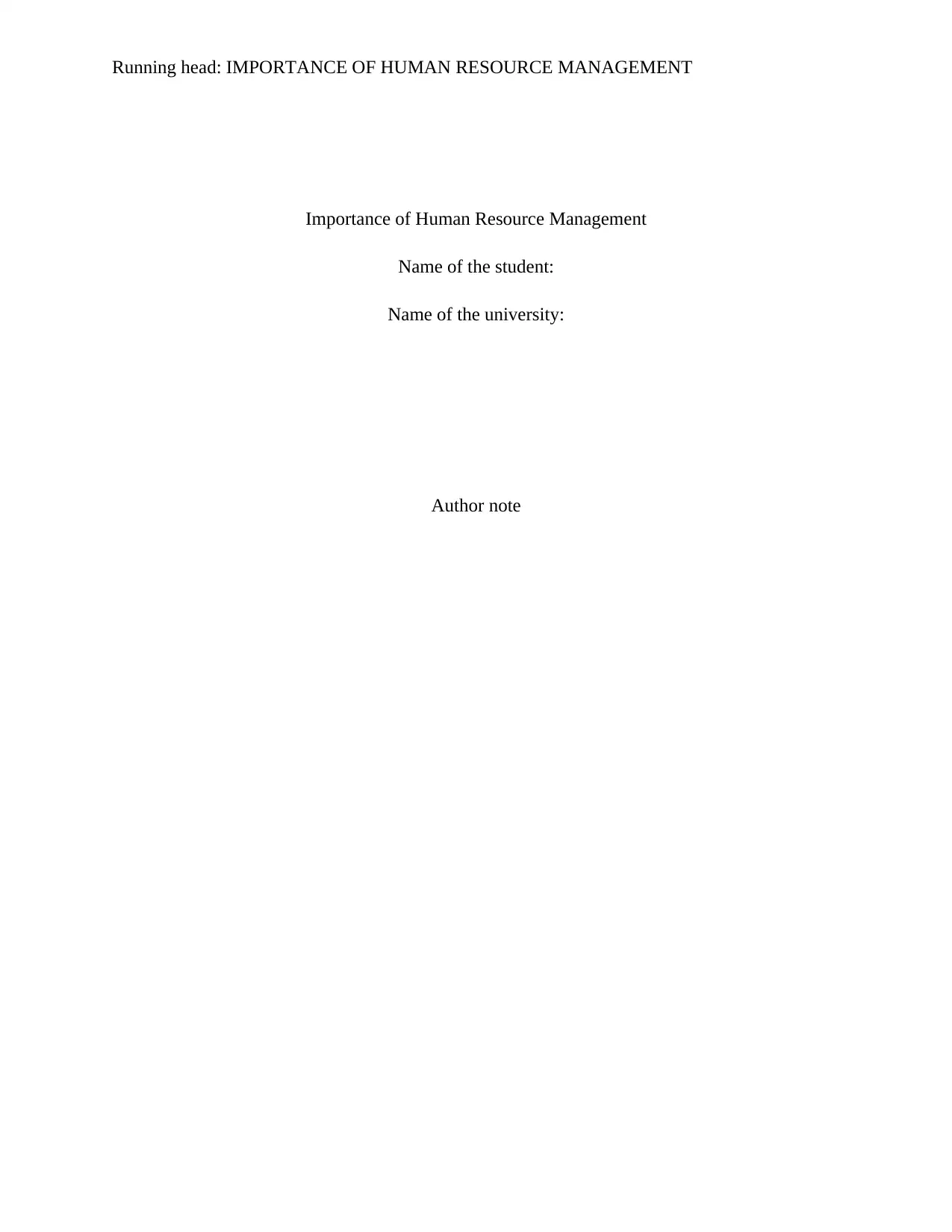
Running head: IMPORTANCE OF HUMAN RESOURCE MANAGEMENT
Importance of Human Resource Management
Name of the student:
Name of the university:
Author note
Importance of Human Resource Management
Name of the student:
Name of the university:
Author note
Secure Best Marks with AI Grader
Need help grading? Try our AI Grader for instant feedback on your assignments.
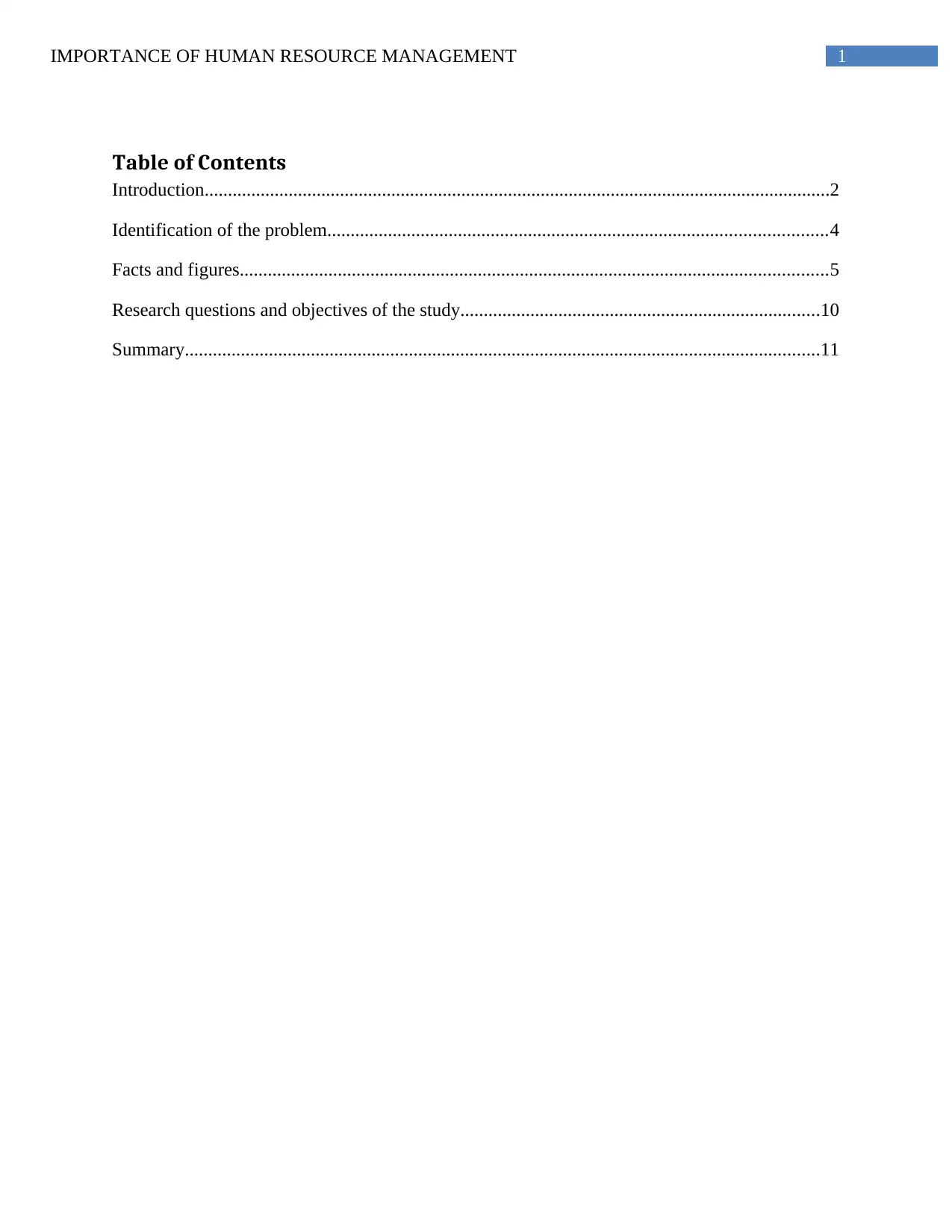
1IMPORTANCE OF HUMAN RESOURCE MANAGEMENT
Table of Contents
Introduction......................................................................................................................................2
Identification of the problem...........................................................................................................4
Facts and figures..............................................................................................................................5
Research questions and objectives of the study.............................................................................10
Summary........................................................................................................................................11
Table of Contents
Introduction......................................................................................................................................2
Identification of the problem...........................................................................................................4
Facts and figures..............................................................................................................................5
Research questions and objectives of the study.............................................................................10
Summary........................................................................................................................................11
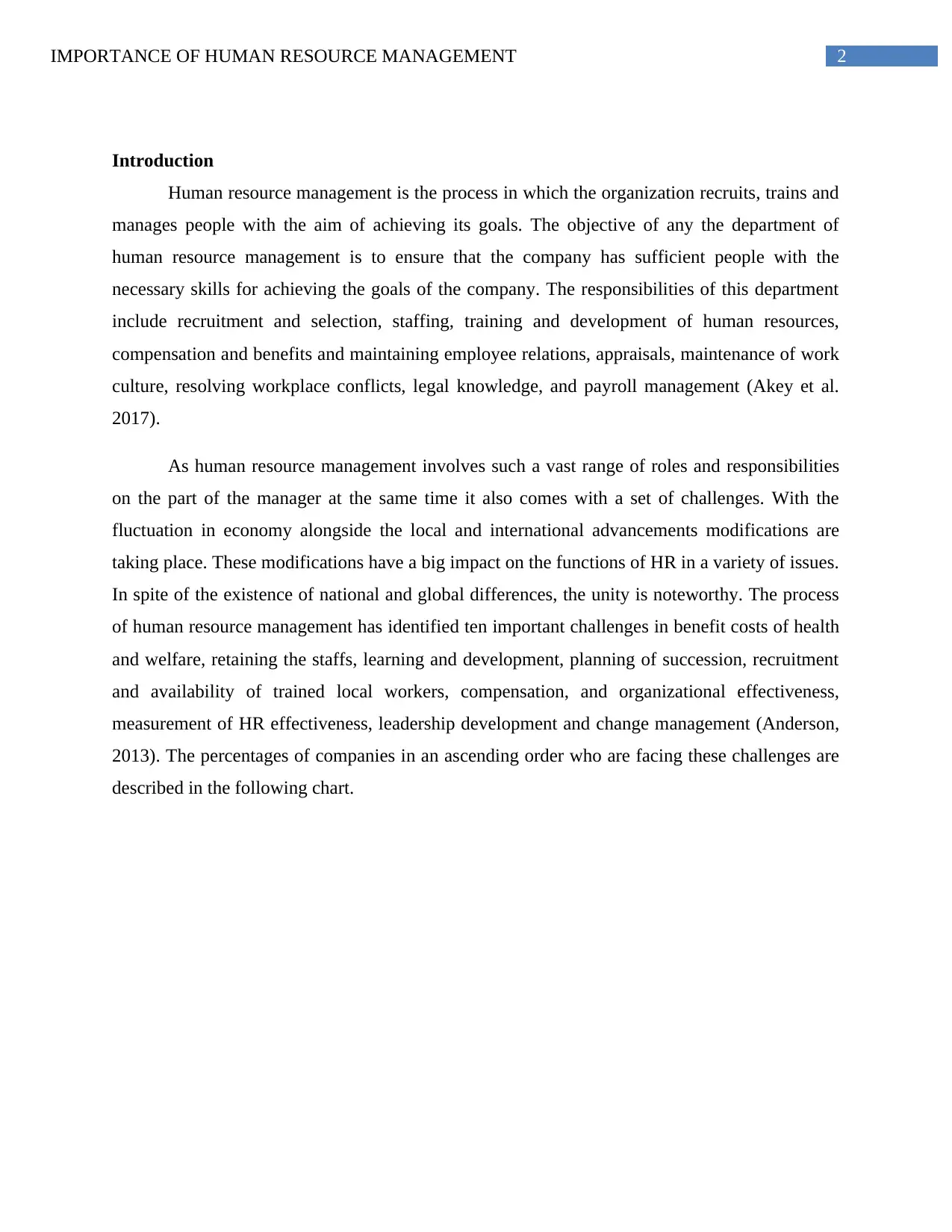
2IMPORTANCE OF HUMAN RESOURCE MANAGEMENT
Introduction
Human resource management is the process in which the organization recruits, trains and
manages people with the aim of achieving its goals. The objective of any the department of
human resource management is to ensure that the company has sufficient people with the
necessary skills for achieving the goals of the company. The responsibilities of this department
include recruitment and selection, staffing, training and development of human resources,
compensation and benefits and maintaining employee relations, appraisals, maintenance of work
culture, resolving workplace conflicts, legal knowledge, and payroll management (Akey et al.
2017).
As human resource management involves such a vast range of roles and responsibilities
on the part of the manager at the same time it also comes with a set of challenges. With the
fluctuation in economy alongside the local and international advancements modifications are
taking place. These modifications have a big impact on the functions of HR in a variety of issues.
In spite of the existence of national and global differences, the unity is noteworthy. The process
of human resource management has identified ten important challenges in benefit costs of health
and welfare, retaining the staffs, learning and development, planning of succession, recruitment
and availability of trained local workers, compensation, and organizational effectiveness,
measurement of HR effectiveness, leadership development and change management (Anderson,
2013). The percentages of companies in an ascending order who are facing these challenges are
described in the following chart.
Introduction
Human resource management is the process in which the organization recruits, trains and
manages people with the aim of achieving its goals. The objective of any the department of
human resource management is to ensure that the company has sufficient people with the
necessary skills for achieving the goals of the company. The responsibilities of this department
include recruitment and selection, staffing, training and development of human resources,
compensation and benefits and maintaining employee relations, appraisals, maintenance of work
culture, resolving workplace conflicts, legal knowledge, and payroll management (Akey et al.
2017).
As human resource management involves such a vast range of roles and responsibilities
on the part of the manager at the same time it also comes with a set of challenges. With the
fluctuation in economy alongside the local and international advancements modifications are
taking place. These modifications have a big impact on the functions of HR in a variety of issues.
In spite of the existence of national and global differences, the unity is noteworthy. The process
of human resource management has identified ten important challenges in benefit costs of health
and welfare, retaining the staffs, learning and development, planning of succession, recruitment
and availability of trained local workers, compensation, and organizational effectiveness,
measurement of HR effectiveness, leadership development and change management (Anderson,
2013). The percentages of companies in an ascending order who are facing these challenges are
described in the following chart.
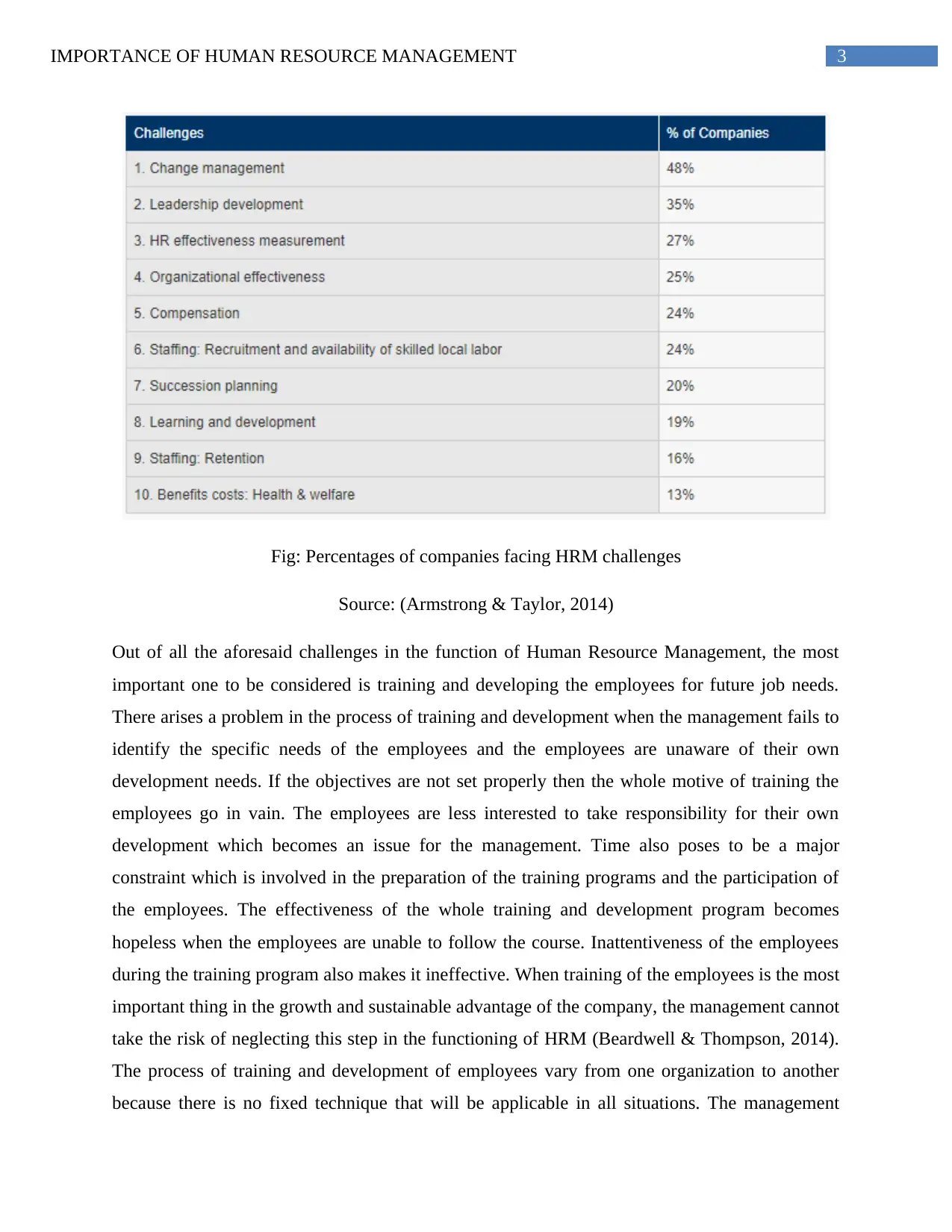
3IMPORTANCE OF HUMAN RESOURCE MANAGEMENT
Fig: Percentages of companies facing HRM challenges
Source: (Armstrong & Taylor, 2014)
Out of all the aforesaid challenges in the function of Human Resource Management, the most
important one to be considered is training and developing the employees for future job needs.
There arises a problem in the process of training and development when the management fails to
identify the specific needs of the employees and the employees are unaware of their own
development needs. If the objectives are not set properly then the whole motive of training the
employees go in vain. The employees are less interested to take responsibility for their own
development which becomes an issue for the management. Time also poses to be a major
constraint which is involved in the preparation of the training programs and the participation of
the employees. The effectiveness of the whole training and development program becomes
hopeless when the employees are unable to follow the course. Inattentiveness of the employees
during the training program also makes it ineffective. When training of the employees is the most
important thing in the growth and sustainable advantage of the company, the management cannot
take the risk of neglecting this step in the functioning of HRM (Beardwell & Thompson, 2014).
The process of training and development of employees vary from one organization to another
because there is no fixed technique that will be applicable in all situations. The management
Fig: Percentages of companies facing HRM challenges
Source: (Armstrong & Taylor, 2014)
Out of all the aforesaid challenges in the function of Human Resource Management, the most
important one to be considered is training and developing the employees for future job needs.
There arises a problem in the process of training and development when the management fails to
identify the specific needs of the employees and the employees are unaware of their own
development needs. If the objectives are not set properly then the whole motive of training the
employees go in vain. The employees are less interested to take responsibility for their own
development which becomes an issue for the management. Time also poses to be a major
constraint which is involved in the preparation of the training programs and the participation of
the employees. The effectiveness of the whole training and development program becomes
hopeless when the employees are unable to follow the course. Inattentiveness of the employees
during the training program also makes it ineffective. When training of the employees is the most
important thing in the growth and sustainable advantage of the company, the management cannot
take the risk of neglecting this step in the functioning of HRM (Beardwell & Thompson, 2014).
The process of training and development of employees vary from one organization to another
because there is no fixed technique that will be applicable in all situations. The management
Secure Best Marks with AI Grader
Need help grading? Try our AI Grader for instant feedback on your assignments.
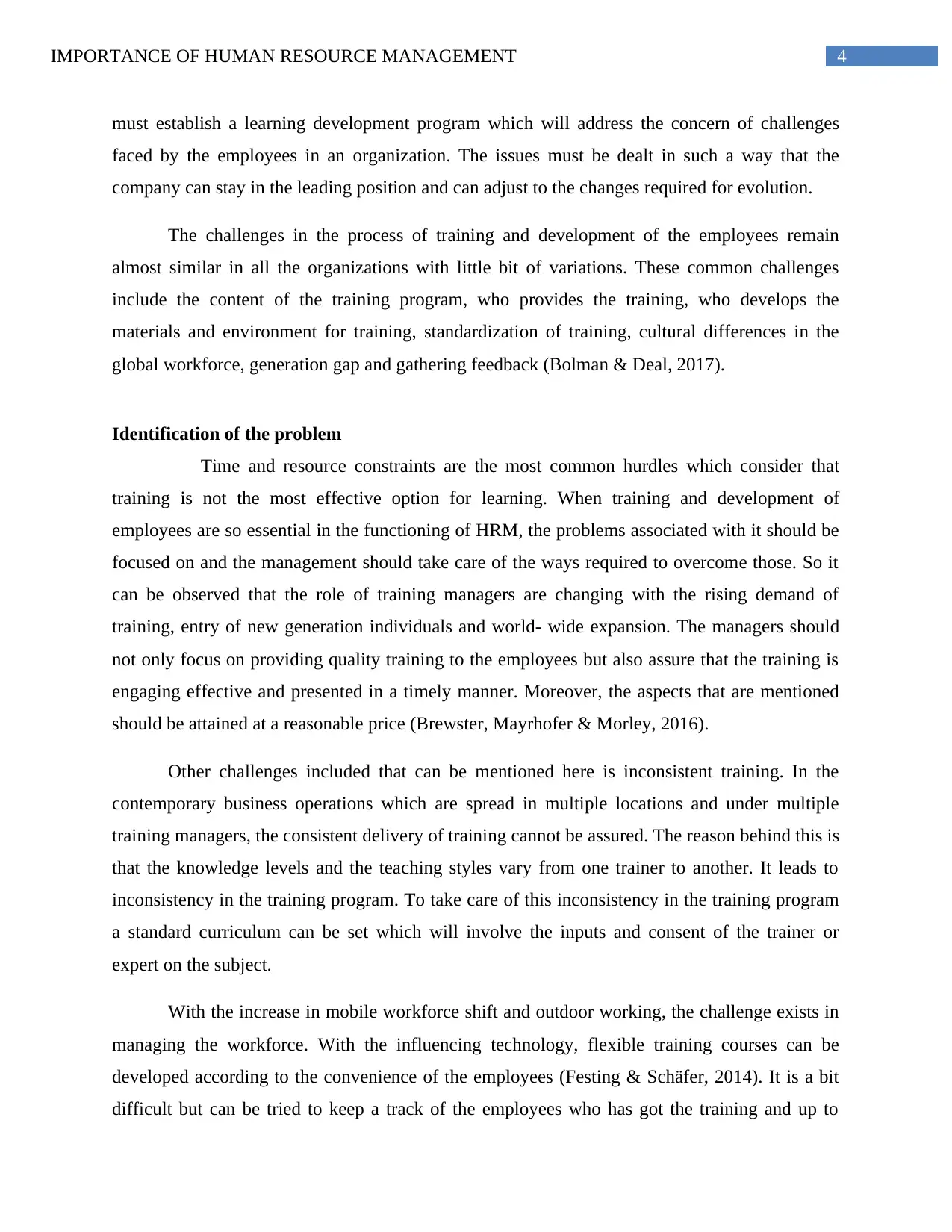
4IMPORTANCE OF HUMAN RESOURCE MANAGEMENT
must establish a learning development program which will address the concern of challenges
faced by the employees in an organization. The issues must be dealt in such a way that the
company can stay in the leading position and can adjust to the changes required for evolution.
The challenges in the process of training and development of the employees remain
almost similar in all the organizations with little bit of variations. These common challenges
include the content of the training program, who provides the training, who develops the
materials and environment for training, standardization of training, cultural differences in the
global workforce, generation gap and gathering feedback (Bolman & Deal, 2017).
Identification of the problem
Time and resource constraints are the most common hurdles which consider that
training is not the most effective option for learning. When training and development of
employees are so essential in the functioning of HRM, the problems associated with it should be
focused on and the management should take care of the ways required to overcome those. So it
can be observed that the role of training managers are changing with the rising demand of
training, entry of new generation individuals and world- wide expansion. The managers should
not only focus on providing quality training to the employees but also assure that the training is
engaging effective and presented in a timely manner. Moreover, the aspects that are mentioned
should be attained at a reasonable price (Brewster, Mayrhofer & Morley, 2016).
Other challenges included that can be mentioned here is inconsistent training. In the
contemporary business operations which are spread in multiple locations and under multiple
training managers, the consistent delivery of training cannot be assured. The reason behind this is
that the knowledge levels and the teaching styles vary from one trainer to another. It leads to
inconsistency in the training program. To take care of this inconsistency in the training program
a standard curriculum can be set which will involve the inputs and consent of the trainer or
expert on the subject.
With the increase in mobile workforce shift and outdoor working, the challenge exists in
managing the workforce. With the influencing technology, flexible training courses can be
developed according to the convenience of the employees (Festing & Schäfer, 2014). It is a bit
difficult but can be tried to keep a track of the employees who has got the training and up to
must establish a learning development program which will address the concern of challenges
faced by the employees in an organization. The issues must be dealt in such a way that the
company can stay in the leading position and can adjust to the changes required for evolution.
The challenges in the process of training and development of the employees remain
almost similar in all the organizations with little bit of variations. These common challenges
include the content of the training program, who provides the training, who develops the
materials and environment for training, standardization of training, cultural differences in the
global workforce, generation gap and gathering feedback (Bolman & Deal, 2017).
Identification of the problem
Time and resource constraints are the most common hurdles which consider that
training is not the most effective option for learning. When training and development of
employees are so essential in the functioning of HRM, the problems associated with it should be
focused on and the management should take care of the ways required to overcome those. So it
can be observed that the role of training managers are changing with the rising demand of
training, entry of new generation individuals and world- wide expansion. The managers should
not only focus on providing quality training to the employees but also assure that the training is
engaging effective and presented in a timely manner. Moreover, the aspects that are mentioned
should be attained at a reasonable price (Brewster, Mayrhofer & Morley, 2016).
Other challenges included that can be mentioned here is inconsistent training. In the
contemporary business operations which are spread in multiple locations and under multiple
training managers, the consistent delivery of training cannot be assured. The reason behind this is
that the knowledge levels and the teaching styles vary from one trainer to another. It leads to
inconsistency in the training program. To take care of this inconsistency in the training program
a standard curriculum can be set which will involve the inputs and consent of the trainer or
expert on the subject.
With the increase in mobile workforce shift and outdoor working, the challenge exists in
managing the workforce. With the influencing technology, flexible training courses can be
developed according to the convenience of the employees (Festing & Schäfer, 2014). It is a bit
difficult but can be tried to keep a track of the employees who has got the training and up to
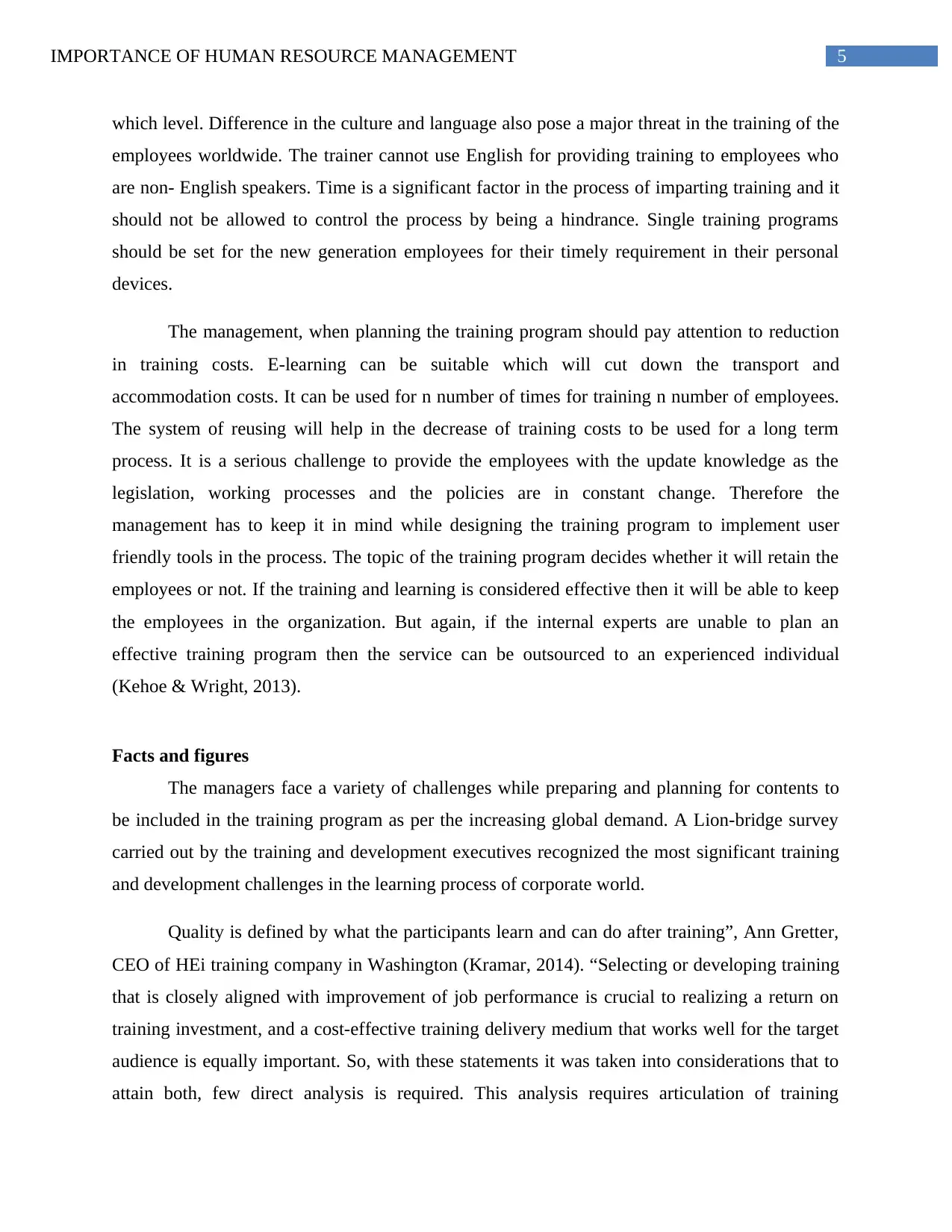
5IMPORTANCE OF HUMAN RESOURCE MANAGEMENT
which level. Difference in the culture and language also pose a major threat in the training of the
employees worldwide. The trainer cannot use English for providing training to employees who
are non- English speakers. Time is a significant factor in the process of imparting training and it
should not be allowed to control the process by being a hindrance. Single training programs
should be set for the new generation employees for their timely requirement in their personal
devices.
The management, when planning the training program should pay attention to reduction
in training costs. E-learning can be suitable which will cut down the transport and
accommodation costs. It can be used for n number of times for training n number of employees.
The system of reusing will help in the decrease of training costs to be used for a long term
process. It is a serious challenge to provide the employees with the update knowledge as the
legislation, working processes and the policies are in constant change. Therefore the
management has to keep it in mind while designing the training program to implement user
friendly tools in the process. The topic of the training program decides whether it will retain the
employees or not. If the training and learning is considered effective then it will be able to keep
the employees in the organization. But again, if the internal experts are unable to plan an
effective training program then the service can be outsourced to an experienced individual
(Kehoe & Wright, 2013).
Facts and figures
The managers face a variety of challenges while preparing and planning for contents to
be included in the training program as per the increasing global demand. A Lion-bridge survey
carried out by the training and development executives recognized the most significant training
and development challenges in the learning process of corporate world.
Quality is defined by what the participants learn and can do after training”, Ann Gretter,
CEO of HEi training company in Washington (Kramar, 2014). “Selecting or developing training
that is closely aligned with improvement of job performance is crucial to realizing a return on
training investment, and a cost-effective training delivery medium that works well for the target
audience is equally important. So, with these statements it was taken into considerations that to
attain both, few direct analysis is required. This analysis requires articulation of training
which level. Difference in the culture and language also pose a major threat in the training of the
employees worldwide. The trainer cannot use English for providing training to employees who
are non- English speakers. Time is a significant factor in the process of imparting training and it
should not be allowed to control the process by being a hindrance. Single training programs
should be set for the new generation employees for their timely requirement in their personal
devices.
The management, when planning the training program should pay attention to reduction
in training costs. E-learning can be suitable which will cut down the transport and
accommodation costs. It can be used for n number of times for training n number of employees.
The system of reusing will help in the decrease of training costs to be used for a long term
process. It is a serious challenge to provide the employees with the update knowledge as the
legislation, working processes and the policies are in constant change. Therefore the
management has to keep it in mind while designing the training program to implement user
friendly tools in the process. The topic of the training program decides whether it will retain the
employees or not. If the training and learning is considered effective then it will be able to keep
the employees in the organization. But again, if the internal experts are unable to plan an
effective training program then the service can be outsourced to an experienced individual
(Kehoe & Wright, 2013).
Facts and figures
The managers face a variety of challenges while preparing and planning for contents to
be included in the training program as per the increasing global demand. A Lion-bridge survey
carried out by the training and development executives recognized the most significant training
and development challenges in the learning process of corporate world.
Quality is defined by what the participants learn and can do after training”, Ann Gretter,
CEO of HEi training company in Washington (Kramar, 2014). “Selecting or developing training
that is closely aligned with improvement of job performance is crucial to realizing a return on
training investment, and a cost-effective training delivery medium that works well for the target
audience is equally important. So, with these statements it was taken into considerations that to
attain both, few direct analysis is required. This analysis requires articulation of training
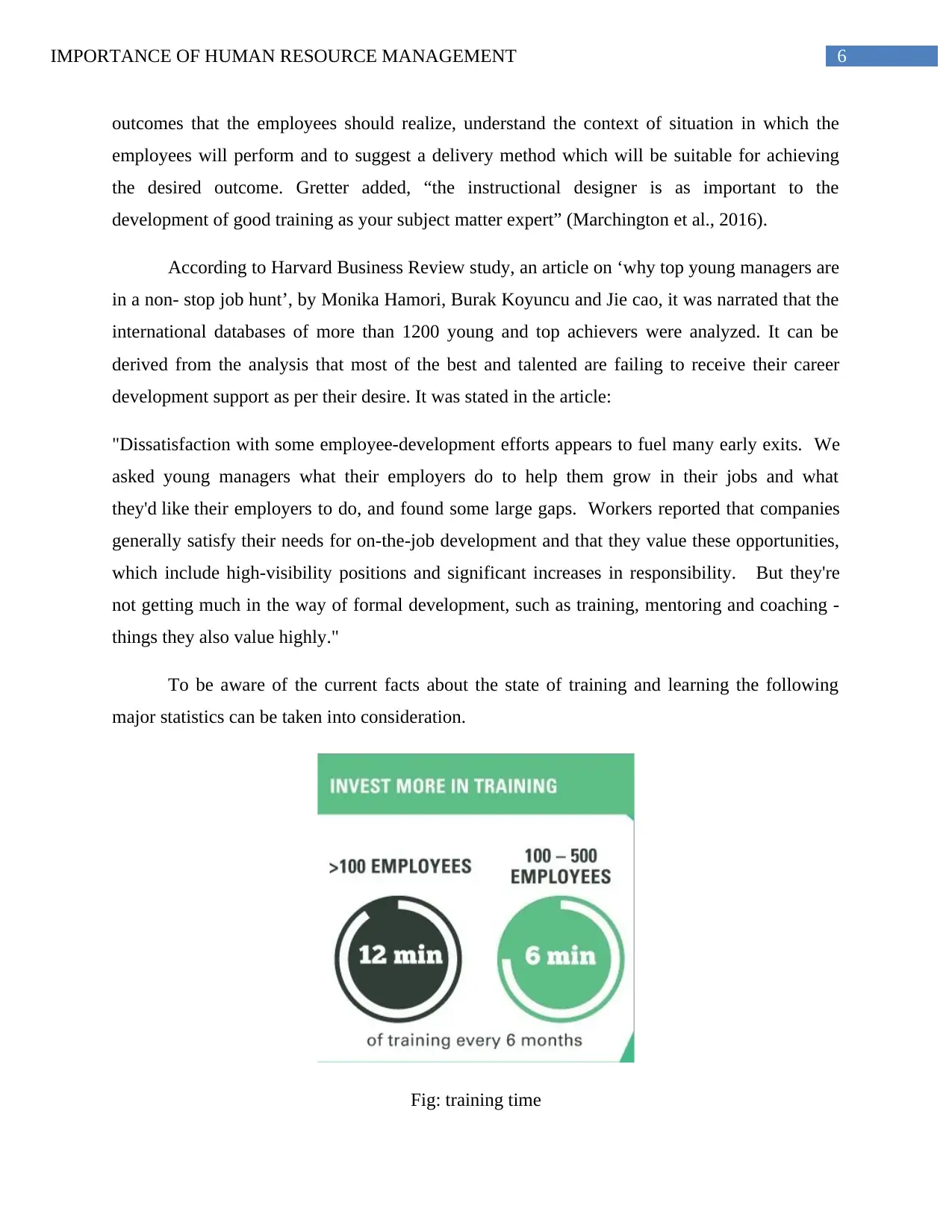
6IMPORTANCE OF HUMAN RESOURCE MANAGEMENT
outcomes that the employees should realize, understand the context of situation in which the
employees will perform and to suggest a delivery method which will be suitable for achieving
the desired outcome. Gretter added, “the instructional designer is as important to the
development of good training as your subject matter expert” (Marchington et al., 2016).
According to Harvard Business Review study, an article on ‘why top young managers are
in a non- stop job hunt’, by Monika Hamori, Burak Koyuncu and Jie cao, it was narrated that the
international databases of more than 1200 young and top achievers were analyzed. It can be
derived from the analysis that most of the best and talented are failing to receive their career
development support as per their desire. It was stated in the article:
"Dissatisfaction with some employee-development efforts appears to fuel many early exits. We
asked young managers what their employers do to help them grow in their jobs and what
they'd like their employers to do, and found some large gaps. Workers reported that companies
generally satisfy their needs for on-the-job development and that they value these opportunities,
which include high-visibility positions and significant increases in responsibility. But they're
not getting much in the way of formal development, such as training, mentoring and coaching -
things they also value highly."
To be aware of the current facts about the state of training and learning the following
major statistics can be taken into consideration.
Fig: training time
outcomes that the employees should realize, understand the context of situation in which the
employees will perform and to suggest a delivery method which will be suitable for achieving
the desired outcome. Gretter added, “the instructional designer is as important to the
development of good training as your subject matter expert” (Marchington et al., 2016).
According to Harvard Business Review study, an article on ‘why top young managers are
in a non- stop job hunt’, by Monika Hamori, Burak Koyuncu and Jie cao, it was narrated that the
international databases of more than 1200 young and top achievers were analyzed. It can be
derived from the analysis that most of the best and talented are failing to receive their career
development support as per their desire. It was stated in the article:
"Dissatisfaction with some employee-development efforts appears to fuel many early exits. We
asked young managers what their employers do to help them grow in their jobs and what
they'd like their employers to do, and found some large gaps. Workers reported that companies
generally satisfy their needs for on-the-job development and that they value these opportunities,
which include high-visibility positions and significant increases in responsibility. But they're
not getting much in the way of formal development, such as training, mentoring and coaching -
things they also value highly."
To be aware of the current facts about the state of training and learning the following
major statistics can be taken into consideration.
Fig: training time
Paraphrase This Document
Need a fresh take? Get an instant paraphrase of this document with our AI Paraphraser
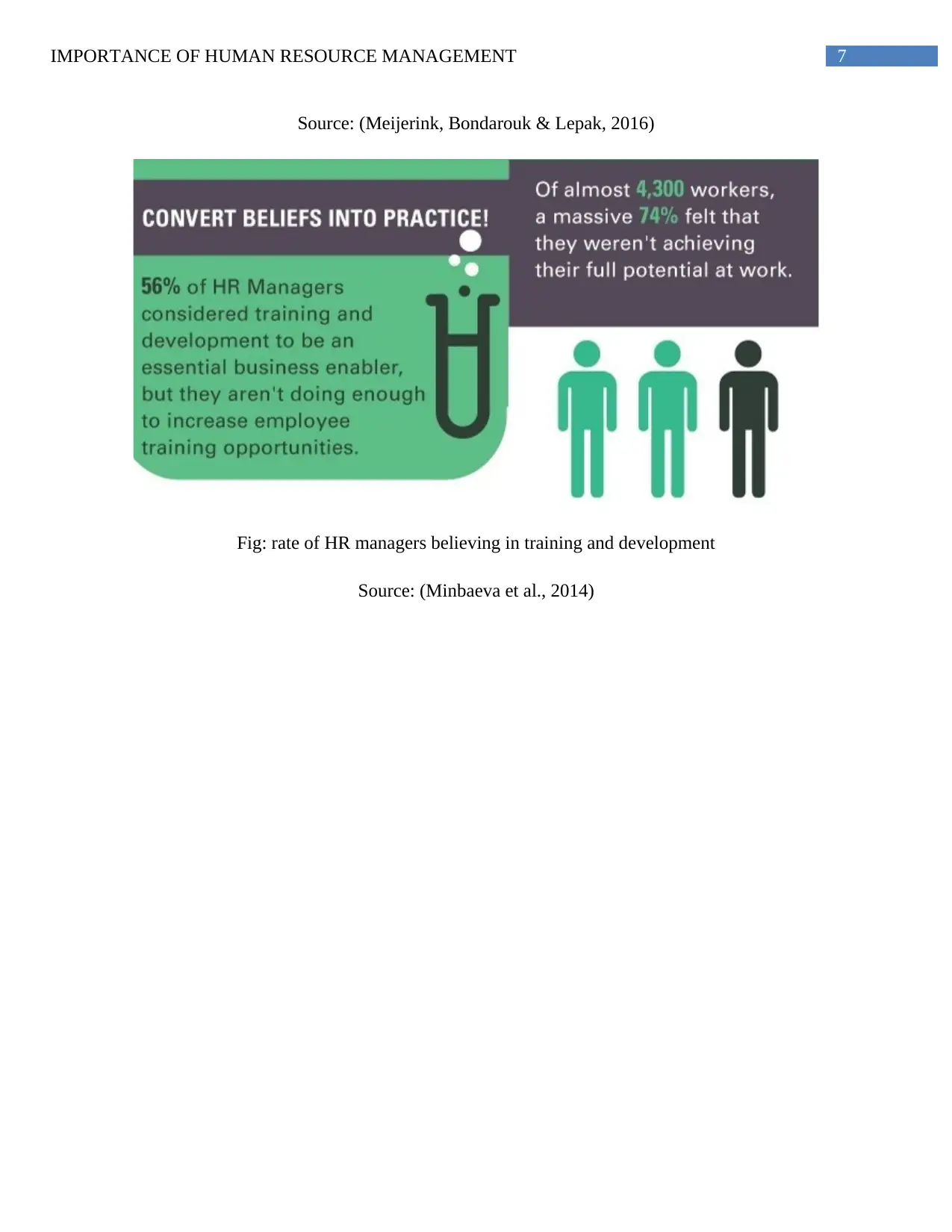
7IMPORTANCE OF HUMAN RESOURCE MANAGEMENT
Source: (Meijerink, Bondarouk & Lepak, 2016)
Fig: rate of HR managers believing in training and development
Source: (Minbaeva et al., 2014)
Source: (Meijerink, Bondarouk & Lepak, 2016)
Fig: rate of HR managers believing in training and development
Source: (Minbaeva et al., 2014)
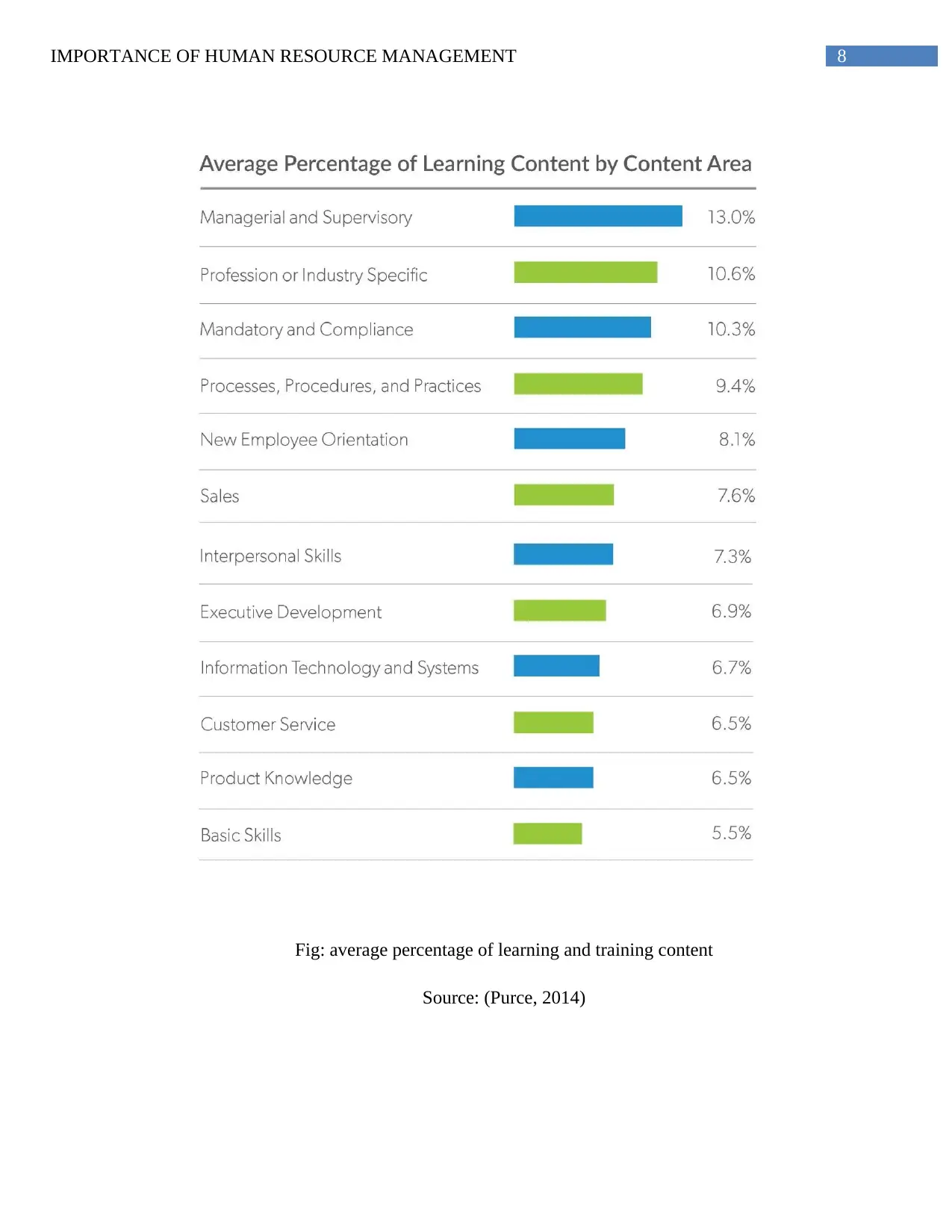
8IMPORTANCE OF HUMAN RESOURCE MANAGEMENT
Fig: average percentage of learning and training content
Source: (Purce, 2014)
Fig: average percentage of learning and training content
Source: (Purce, 2014)
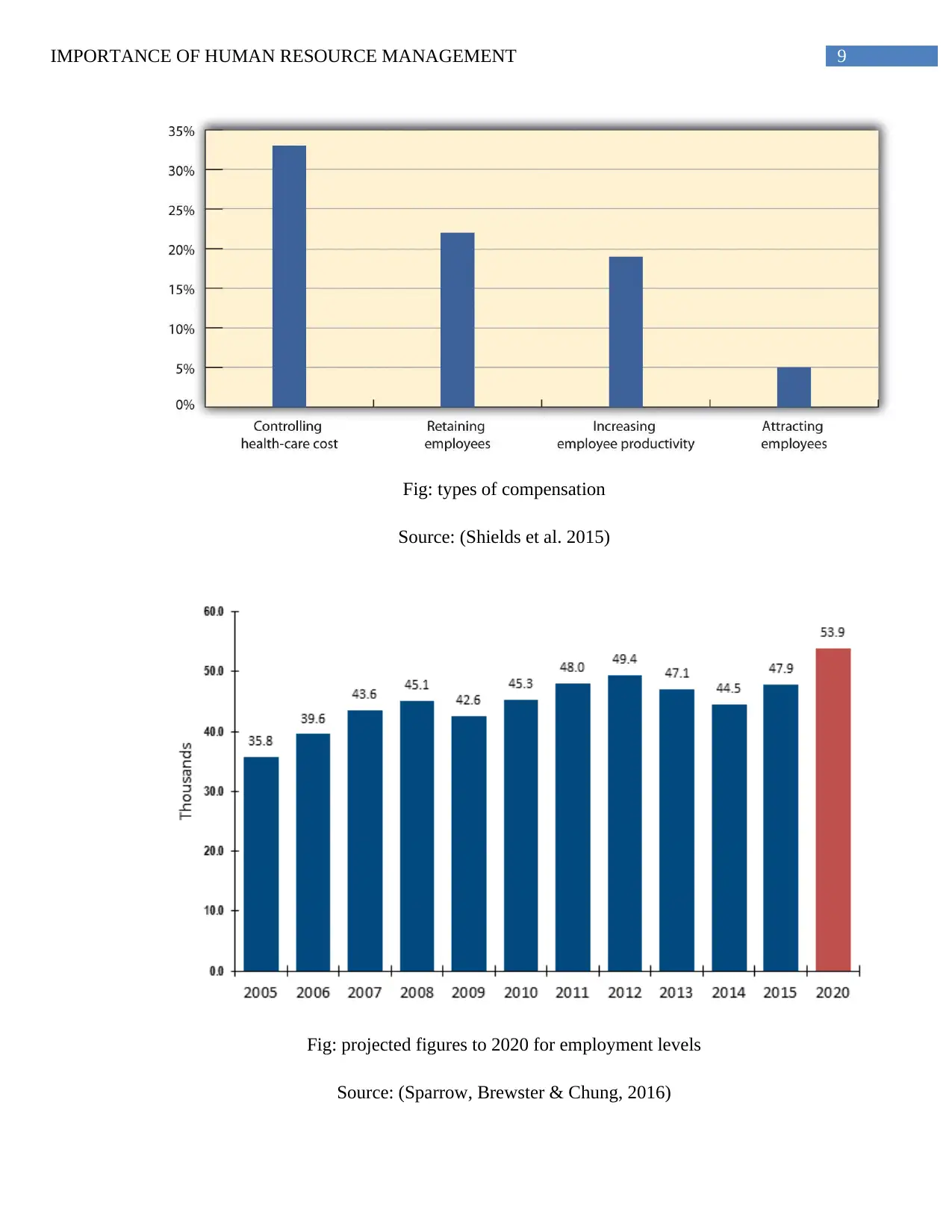
9IMPORTANCE OF HUMAN RESOURCE MANAGEMENT
Fig: types of compensation
Source: (Shields et al. 2015)
Fig: projected figures to 2020 for employment levels
Source: (Sparrow, Brewster & Chung, 2016)
Fig: types of compensation
Source: (Shields et al. 2015)
Fig: projected figures to 2020 for employment levels
Source: (Sparrow, Brewster & Chung, 2016)
Secure Best Marks with AI Grader
Need help grading? Try our AI Grader for instant feedback on your assignments.
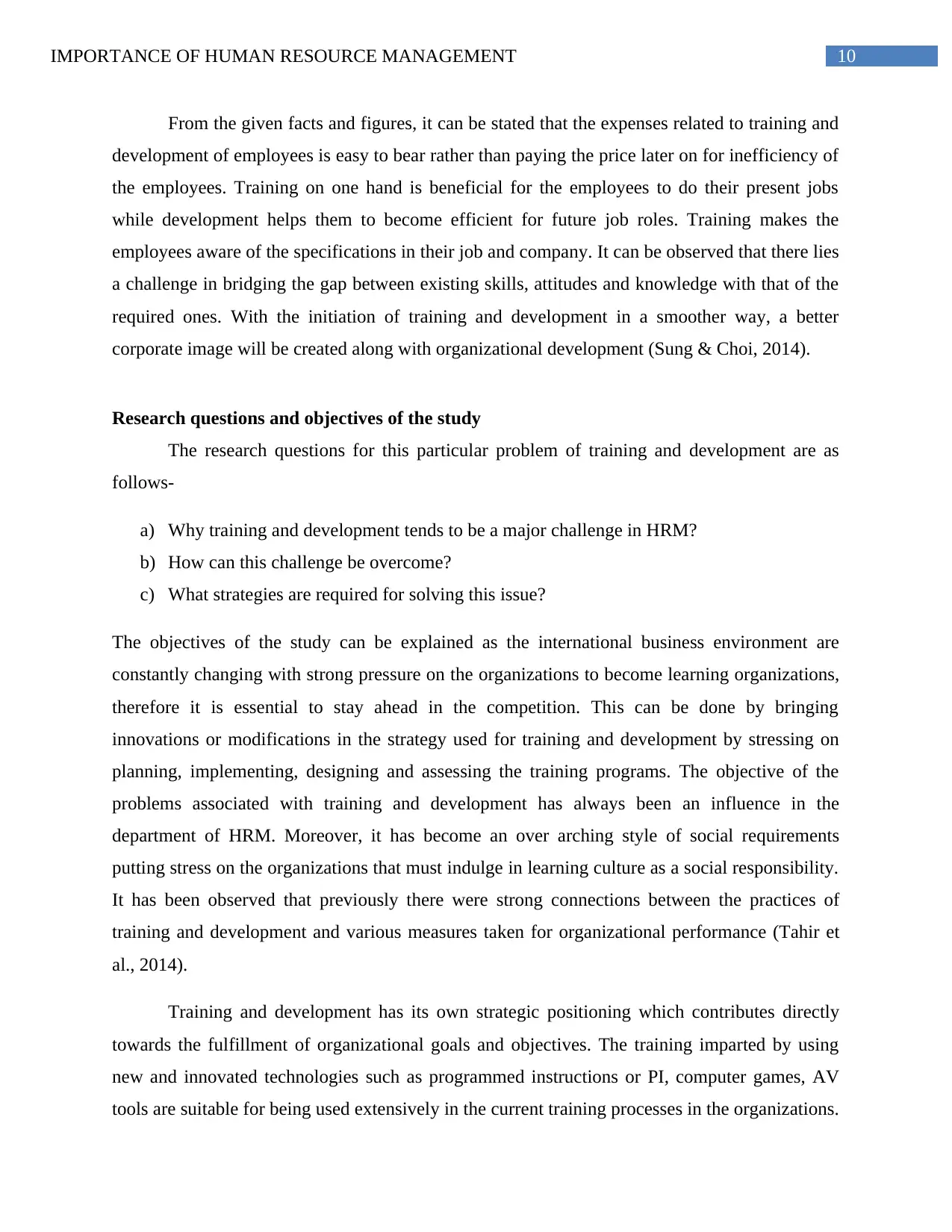
10IMPORTANCE OF HUMAN RESOURCE MANAGEMENT
From the given facts and figures, it can be stated that the expenses related to training and
development of employees is easy to bear rather than paying the price later on for inefficiency of
the employees. Training on one hand is beneficial for the employees to do their present jobs
while development helps them to become efficient for future job roles. Training makes the
employees aware of the specifications in their job and company. It can be observed that there lies
a challenge in bridging the gap between existing skills, attitudes and knowledge with that of the
required ones. With the initiation of training and development in a smoother way, a better
corporate image will be created along with organizational development (Sung & Choi, 2014).
Research questions and objectives of the study
The research questions for this particular problem of training and development are as
follows-
a) Why training and development tends to be a major challenge in HRM?
b) How can this challenge be overcome?
c) What strategies are required for solving this issue?
The objectives of the study can be explained as the international business environment are
constantly changing with strong pressure on the organizations to become learning organizations,
therefore it is essential to stay ahead in the competition. This can be done by bringing
innovations or modifications in the strategy used for training and development by stressing on
planning, implementing, designing and assessing the training programs. The objective of the
problems associated with training and development has always been an influence in the
department of HRM. Moreover, it has become an over arching style of social requirements
putting stress on the organizations that must indulge in learning culture as a social responsibility.
It has been observed that previously there were strong connections between the practices of
training and development and various measures taken for organizational performance (Tahir et
al., 2014).
Training and development has its own strategic positioning which contributes directly
towards the fulfillment of organizational goals and objectives. The training imparted by using
new and innovated technologies such as programmed instructions or PI, computer games, AV
tools are suitable for being used extensively in the current training processes in the organizations.
From the given facts and figures, it can be stated that the expenses related to training and
development of employees is easy to bear rather than paying the price later on for inefficiency of
the employees. Training on one hand is beneficial for the employees to do their present jobs
while development helps them to become efficient for future job roles. Training makes the
employees aware of the specifications in their job and company. It can be observed that there lies
a challenge in bridging the gap between existing skills, attitudes and knowledge with that of the
required ones. With the initiation of training and development in a smoother way, a better
corporate image will be created along with organizational development (Sung & Choi, 2014).
Research questions and objectives of the study
The research questions for this particular problem of training and development are as
follows-
a) Why training and development tends to be a major challenge in HRM?
b) How can this challenge be overcome?
c) What strategies are required for solving this issue?
The objectives of the study can be explained as the international business environment are
constantly changing with strong pressure on the organizations to become learning organizations,
therefore it is essential to stay ahead in the competition. This can be done by bringing
innovations or modifications in the strategy used for training and development by stressing on
planning, implementing, designing and assessing the training programs. The objective of the
problems associated with training and development has always been an influence in the
department of HRM. Moreover, it has become an over arching style of social requirements
putting stress on the organizations that must indulge in learning culture as a social responsibility.
It has been observed that previously there were strong connections between the practices of
training and development and various measures taken for organizational performance (Tahir et
al., 2014).
Training and development has its own strategic positioning which contributes directly
towards the fulfillment of organizational goals and objectives. The training imparted by using
new and innovated technologies such as programmed instructions or PI, computer games, AV
tools are suitable for being used extensively in the current training processes in the organizations.
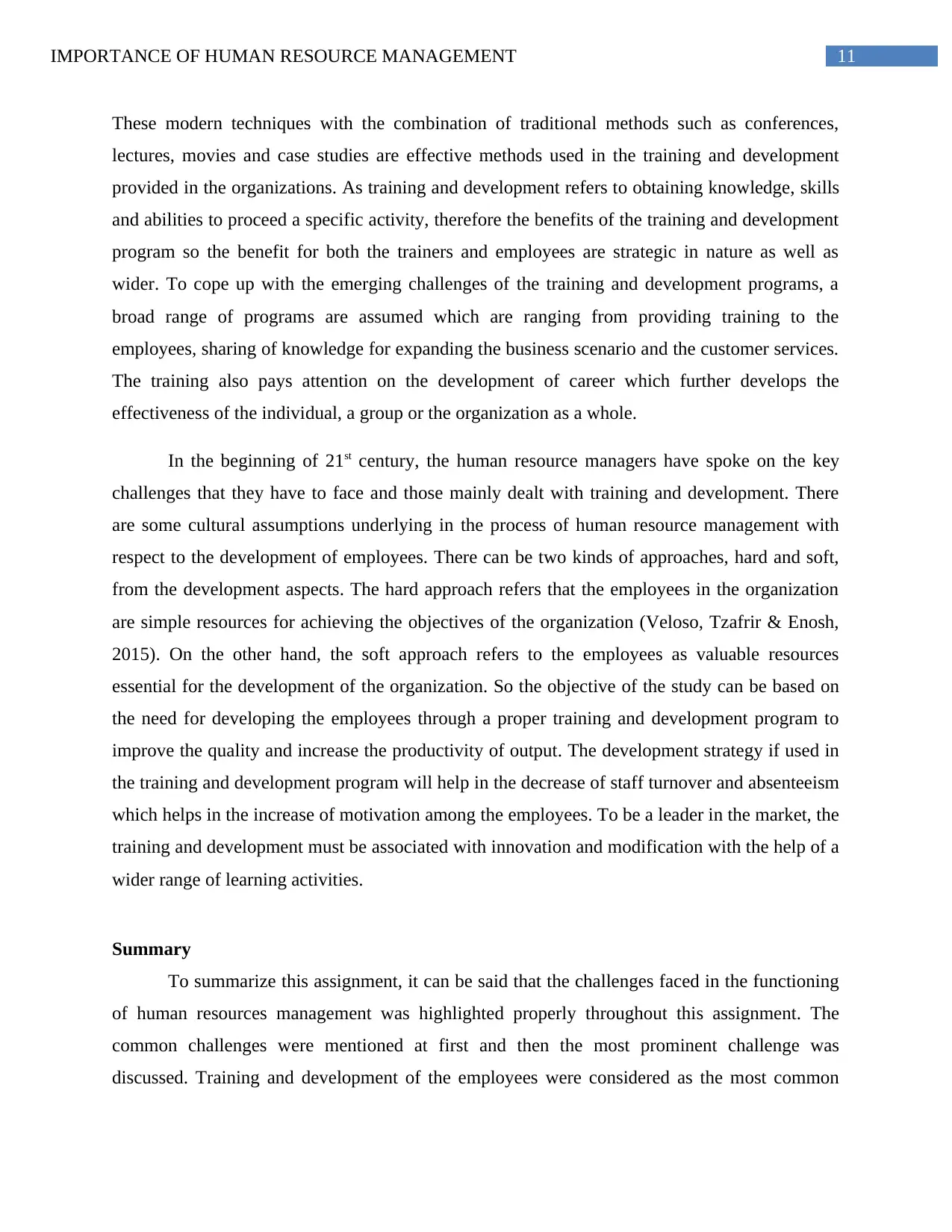
11IMPORTANCE OF HUMAN RESOURCE MANAGEMENT
These modern techniques with the combination of traditional methods such as conferences,
lectures, movies and case studies are effective methods used in the training and development
provided in the organizations. As training and development refers to obtaining knowledge, skills
and abilities to proceed a specific activity, therefore the benefits of the training and development
program so the benefit for both the trainers and employees are strategic in nature as well as
wider. To cope up with the emerging challenges of the training and development programs, a
broad range of programs are assumed which are ranging from providing training to the
employees, sharing of knowledge for expanding the business scenario and the customer services.
The training also pays attention on the development of career which further develops the
effectiveness of the individual, a group or the organization as a whole.
In the beginning of 21st century, the human resource managers have spoke on the key
challenges that they have to face and those mainly dealt with training and development. There
are some cultural assumptions underlying in the process of human resource management with
respect to the development of employees. There can be two kinds of approaches, hard and soft,
from the development aspects. The hard approach refers that the employees in the organization
are simple resources for achieving the objectives of the organization (Veloso, Tzafrir & Enosh,
2015). On the other hand, the soft approach refers to the employees as valuable resources
essential for the development of the organization. So the objective of the study can be based on
the need for developing the employees through a proper training and development program to
improve the quality and increase the productivity of output. The development strategy if used in
the training and development program will help in the decrease of staff turnover and absenteeism
which helps in the increase of motivation among the employees. To be a leader in the market, the
training and development must be associated with innovation and modification with the help of a
wider range of learning activities.
Summary
To summarize this assignment, it can be said that the challenges faced in the functioning
of human resources management was highlighted properly throughout this assignment. The
common challenges were mentioned at first and then the most prominent challenge was
discussed. Training and development of the employees were considered as the most common
These modern techniques with the combination of traditional methods such as conferences,
lectures, movies and case studies are effective methods used in the training and development
provided in the organizations. As training and development refers to obtaining knowledge, skills
and abilities to proceed a specific activity, therefore the benefits of the training and development
program so the benefit for both the trainers and employees are strategic in nature as well as
wider. To cope up with the emerging challenges of the training and development programs, a
broad range of programs are assumed which are ranging from providing training to the
employees, sharing of knowledge for expanding the business scenario and the customer services.
The training also pays attention on the development of career which further develops the
effectiveness of the individual, a group or the organization as a whole.
In the beginning of 21st century, the human resource managers have spoke on the key
challenges that they have to face and those mainly dealt with training and development. There
are some cultural assumptions underlying in the process of human resource management with
respect to the development of employees. There can be two kinds of approaches, hard and soft,
from the development aspects. The hard approach refers that the employees in the organization
are simple resources for achieving the objectives of the organization (Veloso, Tzafrir & Enosh,
2015). On the other hand, the soft approach refers to the employees as valuable resources
essential for the development of the organization. So the objective of the study can be based on
the need for developing the employees through a proper training and development program to
improve the quality and increase the productivity of output. The development strategy if used in
the training and development program will help in the decrease of staff turnover and absenteeism
which helps in the increase of motivation among the employees. To be a leader in the market, the
training and development must be associated with innovation and modification with the help of a
wider range of learning activities.
Summary
To summarize this assignment, it can be said that the challenges faced in the functioning
of human resources management was highlighted properly throughout this assignment. The
common challenges were mentioned at first and then the most prominent challenge was
discussed. Training and development of the employees were considered as the most common
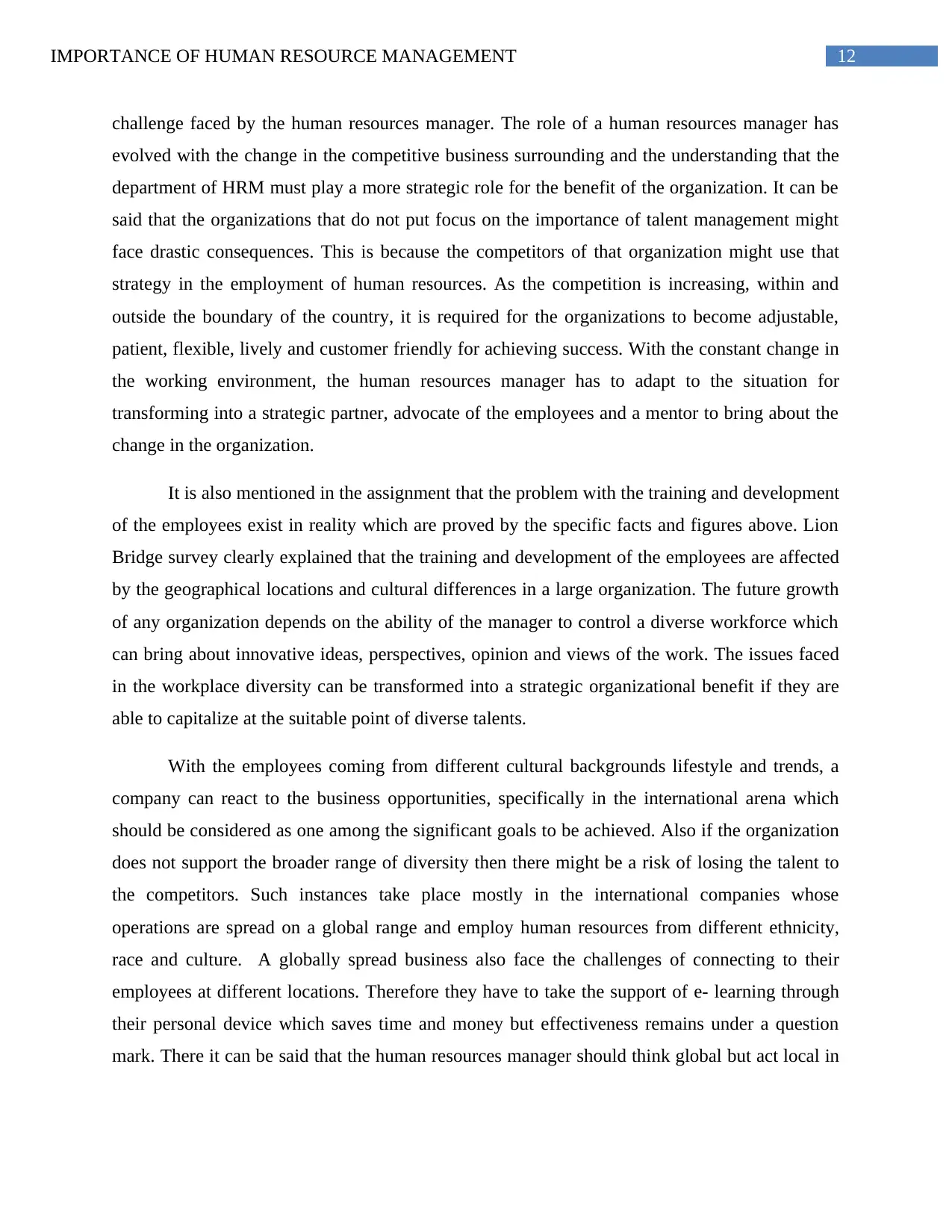
12IMPORTANCE OF HUMAN RESOURCE MANAGEMENT
challenge faced by the human resources manager. The role of a human resources manager has
evolved with the change in the competitive business surrounding and the understanding that the
department of HRM must play a more strategic role for the benefit of the organization. It can be
said that the organizations that do not put focus on the importance of talent management might
face drastic consequences. This is because the competitors of that organization might use that
strategy in the employment of human resources. As the competition is increasing, within and
outside the boundary of the country, it is required for the organizations to become adjustable,
patient, flexible, lively and customer friendly for achieving success. With the constant change in
the working environment, the human resources manager has to adapt to the situation for
transforming into a strategic partner, advocate of the employees and a mentor to bring about the
change in the organization.
It is also mentioned in the assignment that the problem with the training and development
of the employees exist in reality which are proved by the specific facts and figures above. Lion
Bridge survey clearly explained that the training and development of the employees are affected
by the geographical locations and cultural differences in a large organization. The future growth
of any organization depends on the ability of the manager to control a diverse workforce which
can bring about innovative ideas, perspectives, opinion and views of the work. The issues faced
in the workplace diversity can be transformed into a strategic organizational benefit if they are
able to capitalize at the suitable point of diverse talents.
With the employees coming from different cultural backgrounds lifestyle and trends, a
company can react to the business opportunities, specifically in the international arena which
should be considered as one among the significant goals to be achieved. Also if the organization
does not support the broader range of diversity then there might be a risk of losing the talent to
the competitors. Such instances take place mostly in the international companies whose
operations are spread on a global range and employ human resources from different ethnicity,
race and culture. A globally spread business also face the challenges of connecting to their
employees at different locations. Therefore they have to take the support of e- learning through
their personal device which saves time and money but effectiveness remains under a question
mark. There it can be said that the human resources manager should think global but act local in
challenge faced by the human resources manager. The role of a human resources manager has
evolved with the change in the competitive business surrounding and the understanding that the
department of HRM must play a more strategic role for the benefit of the organization. It can be
said that the organizations that do not put focus on the importance of talent management might
face drastic consequences. This is because the competitors of that organization might use that
strategy in the employment of human resources. As the competition is increasing, within and
outside the boundary of the country, it is required for the organizations to become adjustable,
patient, flexible, lively and customer friendly for achieving success. With the constant change in
the working environment, the human resources manager has to adapt to the situation for
transforming into a strategic partner, advocate of the employees and a mentor to bring about the
change in the organization.
It is also mentioned in the assignment that the problem with the training and development
of the employees exist in reality which are proved by the specific facts and figures above. Lion
Bridge survey clearly explained that the training and development of the employees are affected
by the geographical locations and cultural differences in a large organization. The future growth
of any organization depends on the ability of the manager to control a diverse workforce which
can bring about innovative ideas, perspectives, opinion and views of the work. The issues faced
in the workplace diversity can be transformed into a strategic organizational benefit if they are
able to capitalize at the suitable point of diverse talents.
With the employees coming from different cultural backgrounds lifestyle and trends, a
company can react to the business opportunities, specifically in the international arena which
should be considered as one among the significant goals to be achieved. Also if the organization
does not support the broader range of diversity then there might be a risk of losing the talent to
the competitors. Such instances take place mostly in the international companies whose
operations are spread on a global range and employ human resources from different ethnicity,
race and culture. A globally spread business also face the challenges of connecting to their
employees at different locations. Therefore they have to take the support of e- learning through
their personal device which saves time and money but effectiveness remains under a question
mark. There it can be said that the human resources manager should think global but act local in
Paraphrase This Document
Need a fresh take? Get an instant paraphrase of this document with our AI Paraphraser
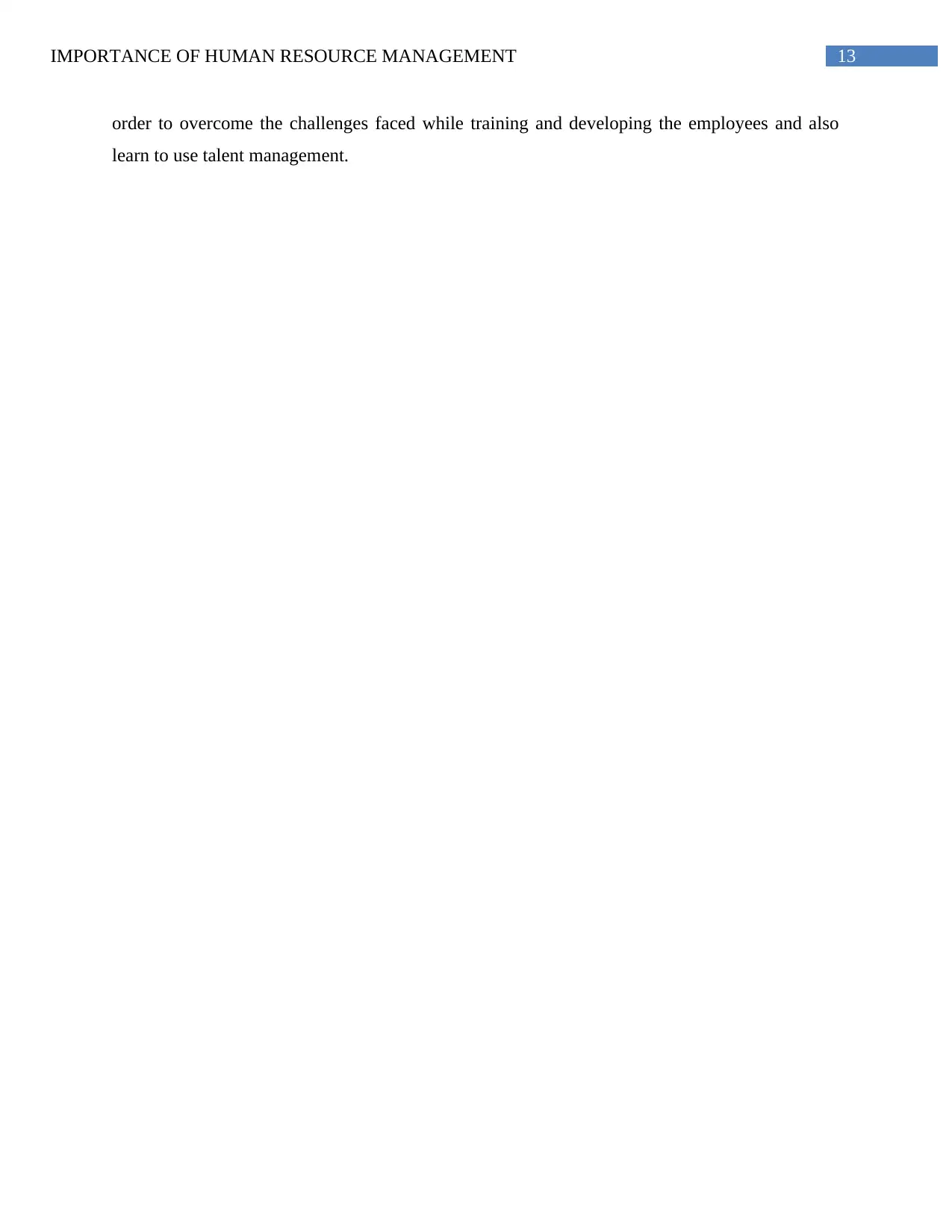
13IMPORTANCE OF HUMAN RESOURCE MANAGEMENT
order to overcome the challenges faced while training and developing the employees and also
learn to use talent management.
order to overcome the challenges faced while training and developing the employees and also
learn to use talent management.
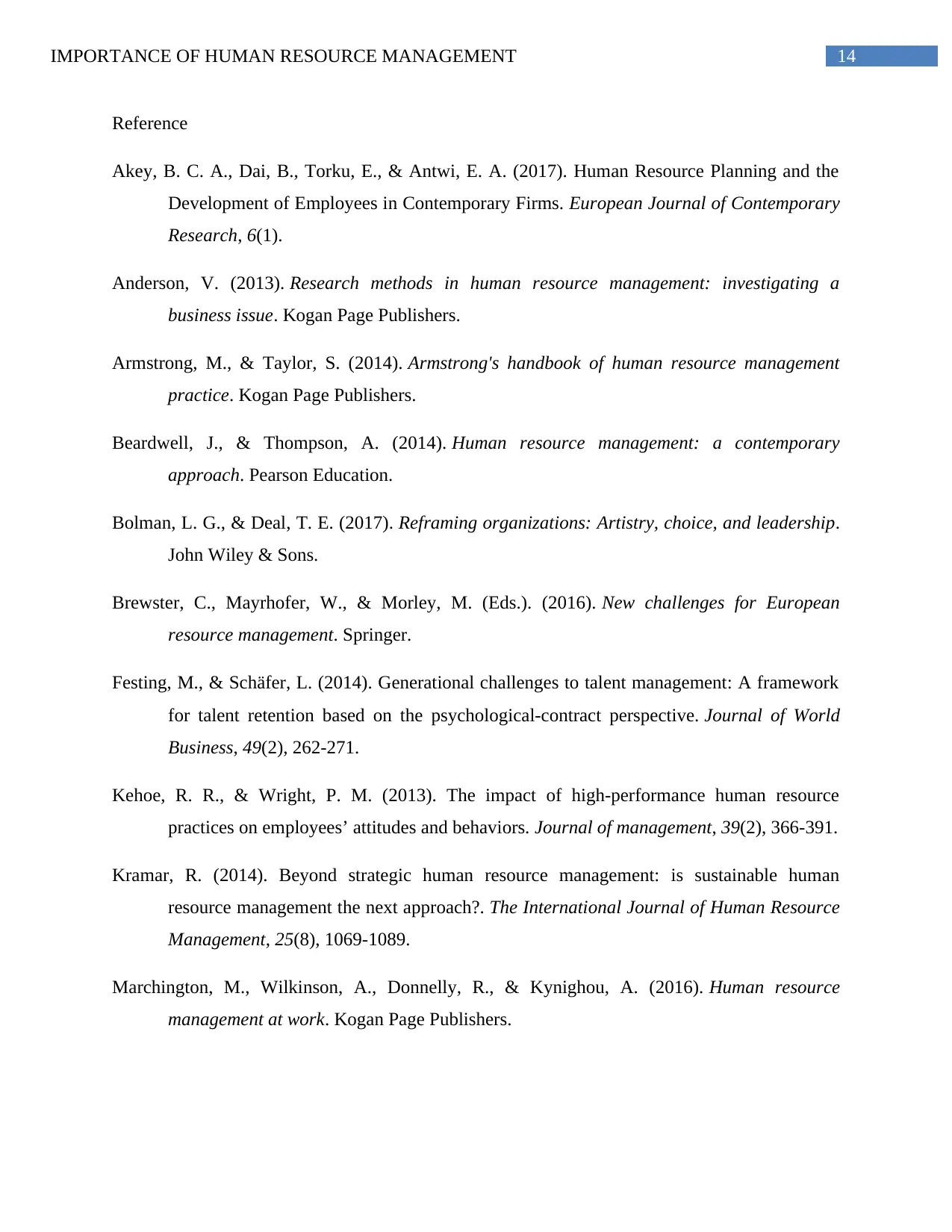
14IMPORTANCE OF HUMAN RESOURCE MANAGEMENT
Reference
Akey, B. C. A., Dai, B., Torku, E., & Antwi, E. A. (2017). Human Resource Planning and the
Development of Employees in Contemporary Firms. European Journal of Contemporary
Research, 6(1).
Anderson, V. (2013). Research methods in human resource management: investigating a
business issue. Kogan Page Publishers.
Armstrong, M., & Taylor, S. (2014). Armstrong's handbook of human resource management
practice. Kogan Page Publishers.
Beardwell, J., & Thompson, A. (2014). Human resource management: a contemporary
approach. Pearson Education.
Bolman, L. G., & Deal, T. E. (2017). Reframing organizations: Artistry, choice, and leadership.
John Wiley & Sons.
Brewster, C., Mayrhofer, W., & Morley, M. (Eds.). (2016). New challenges for European
resource management. Springer.
Festing, M., & Schäfer, L. (2014). Generational challenges to talent management: A framework
for talent retention based on the psychological-contract perspective. Journal of World
Business, 49(2), 262-271.
Kehoe, R. R., & Wright, P. M. (2013). The impact of high-performance human resource
practices on employees’ attitudes and behaviors. Journal of management, 39(2), 366-391.
Kramar, R. (2014). Beyond strategic human resource management: is sustainable human
resource management the next approach?. The International Journal of Human Resource
Management, 25(8), 1069-1089.
Marchington, M., Wilkinson, A., Donnelly, R., & Kynighou, A. (2016). Human resource
management at work. Kogan Page Publishers.
Reference
Akey, B. C. A., Dai, B., Torku, E., & Antwi, E. A. (2017). Human Resource Planning and the
Development of Employees in Contemporary Firms. European Journal of Contemporary
Research, 6(1).
Anderson, V. (2013). Research methods in human resource management: investigating a
business issue. Kogan Page Publishers.
Armstrong, M., & Taylor, S. (2014). Armstrong's handbook of human resource management
practice. Kogan Page Publishers.
Beardwell, J., & Thompson, A. (2014). Human resource management: a contemporary
approach. Pearson Education.
Bolman, L. G., & Deal, T. E. (2017). Reframing organizations: Artistry, choice, and leadership.
John Wiley & Sons.
Brewster, C., Mayrhofer, W., & Morley, M. (Eds.). (2016). New challenges for European
resource management. Springer.
Festing, M., & Schäfer, L. (2014). Generational challenges to talent management: A framework
for talent retention based on the psychological-contract perspective. Journal of World
Business, 49(2), 262-271.
Kehoe, R. R., & Wright, P. M. (2013). The impact of high-performance human resource
practices on employees’ attitudes and behaviors. Journal of management, 39(2), 366-391.
Kramar, R. (2014). Beyond strategic human resource management: is sustainable human
resource management the next approach?. The International Journal of Human Resource
Management, 25(8), 1069-1089.
Marchington, M., Wilkinson, A., Donnelly, R., & Kynighou, A. (2016). Human resource
management at work. Kogan Page Publishers.
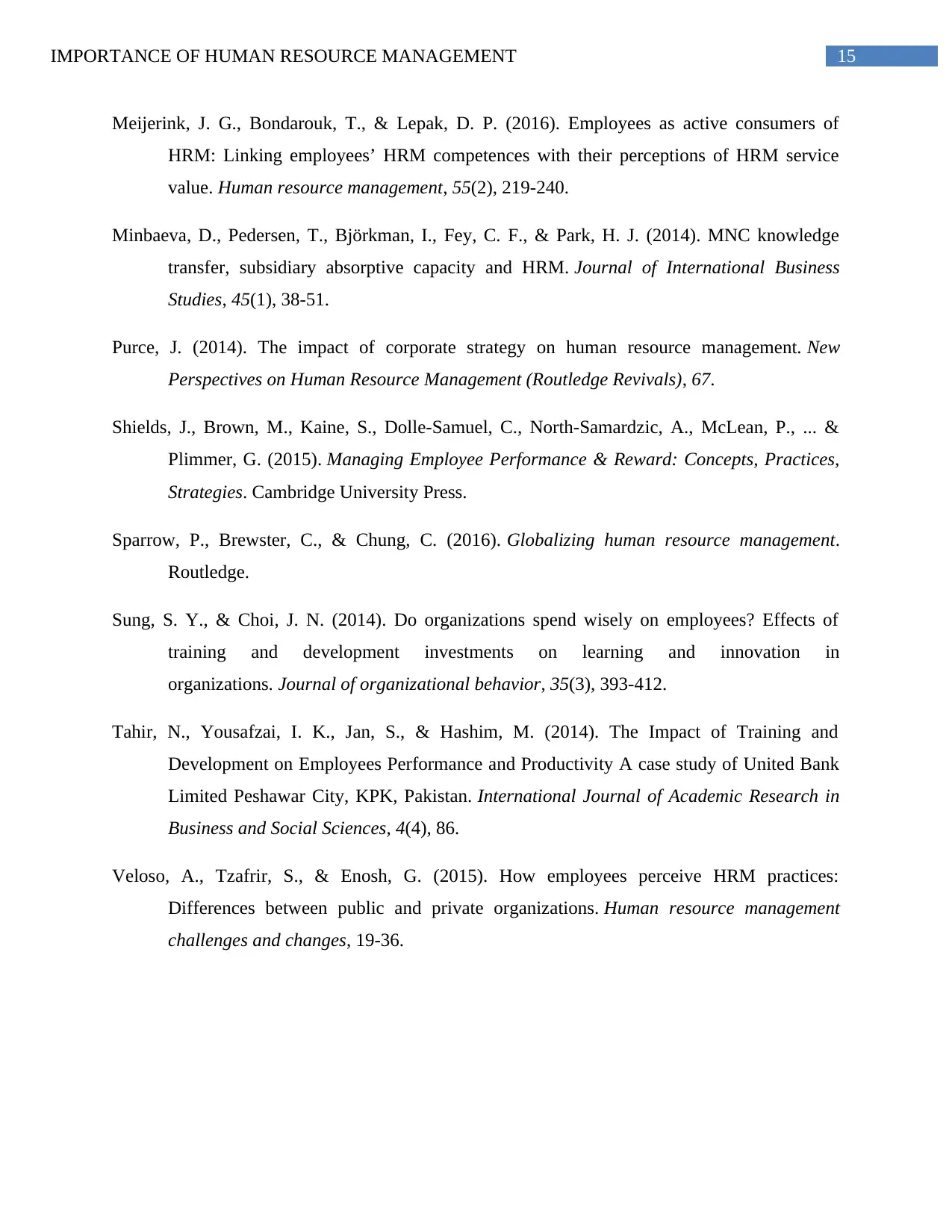
15IMPORTANCE OF HUMAN RESOURCE MANAGEMENT
Meijerink, J. G., Bondarouk, T., & Lepak, D. P. (2016). Employees as active consumers of
HRM: Linking employees’ HRM competences with their perceptions of HRM service
value. Human resource management, 55(2), 219-240.
Minbaeva, D., Pedersen, T., Björkman, I., Fey, C. F., & Park, H. J. (2014). MNC knowledge
transfer, subsidiary absorptive capacity and HRM. Journal of International Business
Studies, 45(1), 38-51.
Purce, J. (2014). The impact of corporate strategy on human resource management. New
Perspectives on Human Resource Management (Routledge Revivals), 67.
Shields, J., Brown, M., Kaine, S., Dolle-Samuel, C., North-Samardzic, A., McLean, P., ... &
Plimmer, G. (2015). Managing Employee Performance & Reward: Concepts, Practices,
Strategies. Cambridge University Press.
Sparrow, P., Brewster, C., & Chung, C. (2016). Globalizing human resource management.
Routledge.
Sung, S. Y., & Choi, J. N. (2014). Do organizations spend wisely on employees? Effects of
training and development investments on learning and innovation in
organizations. Journal of organizational behavior, 35(3), 393-412.
Tahir, N., Yousafzai, I. K., Jan, S., & Hashim, M. (2014). The Impact of Training and
Development on Employees Performance and Productivity A case study of United Bank
Limited Peshawar City, KPK, Pakistan. International Journal of Academic Research in
Business and Social Sciences, 4(4), 86.
Veloso, A., Tzafrir, S., & Enosh, G. (2015). How employees perceive HRM practices:
Differences between public and private organizations. Human resource management
challenges and changes, 19-36.
Meijerink, J. G., Bondarouk, T., & Lepak, D. P. (2016). Employees as active consumers of
HRM: Linking employees’ HRM competences with their perceptions of HRM service
value. Human resource management, 55(2), 219-240.
Minbaeva, D., Pedersen, T., Björkman, I., Fey, C. F., & Park, H. J. (2014). MNC knowledge
transfer, subsidiary absorptive capacity and HRM. Journal of International Business
Studies, 45(1), 38-51.
Purce, J. (2014). The impact of corporate strategy on human resource management. New
Perspectives on Human Resource Management (Routledge Revivals), 67.
Shields, J., Brown, M., Kaine, S., Dolle-Samuel, C., North-Samardzic, A., McLean, P., ... &
Plimmer, G. (2015). Managing Employee Performance & Reward: Concepts, Practices,
Strategies. Cambridge University Press.
Sparrow, P., Brewster, C., & Chung, C. (2016). Globalizing human resource management.
Routledge.
Sung, S. Y., & Choi, J. N. (2014). Do organizations spend wisely on employees? Effects of
training and development investments on learning and innovation in
organizations. Journal of organizational behavior, 35(3), 393-412.
Tahir, N., Yousafzai, I. K., Jan, S., & Hashim, M. (2014). The Impact of Training and
Development on Employees Performance and Productivity A case study of United Bank
Limited Peshawar City, KPK, Pakistan. International Journal of Academic Research in
Business and Social Sciences, 4(4), 86.
Veloso, A., Tzafrir, S., & Enosh, G. (2015). How employees perceive HRM practices:
Differences between public and private organizations. Human resource management
challenges and changes, 19-36.
1 out of 16
Related Documents
Your All-in-One AI-Powered Toolkit for Academic Success.
+13062052269
info@desklib.com
Available 24*7 on WhatsApp / Email
![[object Object]](/_next/static/media/star-bottom.7253800d.svg)
Unlock your academic potential
© 2024 | Zucol Services PVT LTD | All rights reserved.




